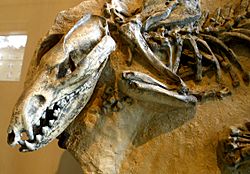Metatheria facts for kids
Quick facts for kids MetatheriaTemporal range: Lower Cretaceous – Holocene, 125 mya to present
|
|
|---|---|
 |
|
| Lycopsis longirostris, an extinct Sparassodont, relatives of the marsupials | |
| Scientific classification | |
| Kingdom: | |
| Phylum: | |
| Class: | |
| Subclass: | |
| Infraclass: |
Metatheria
|
| Orders and infraclasses | |
|
|
Metatheria is a group of mammals that includes all marsupials. It also includes their closest fossil relatives, like the sparassodonts. These animals are different from other mammals because of their teeth. They usually have five upper and four lower incisors, one canine, three premolars, and four molars.
The first known Metatherian was Sinodelphys. Its fossils were found in China and date back to the Lower Cretaceous period. This was a very long time ago!
The scientist Thomas Henry Huxley first described Metatheria in 1880. He also named their close relatives, the Eutheria, which are sometimes called "true beasts." Both Metatheria and Eutheria are part of the Theria group. This group includes all living mammals except for monotremes, like the platypus.
Amazing Births: How Metatherians Reproduce
Metatherian mothers have a special way of giving birth. Their babies are born very tiny and undeveloped. They are often described as "larval-like" because they look more like larvae than fully formed animals.
When a Metatherian baby is born, its back legs are not fully grown. It has to crawl from the birth canal to its mother's pouch, called a marsupium. Once inside the pouch, the baby finds a nipple and attaches to it. The baby's mouth forms an "O" shape around the nipple. The nipple then swells up, holding the baby securely in place. This way, the baby can stay safe and feed inside the pouch until it grows bigger.
The name "Metatheria" comes from Greek words. Meta- means "other," and theria means "beasts." So, Metatheria roughly means "the other beasts." This is different from Eutheria, which means "true beasts."
Metatheria Through Time: Their Evolutionary History
Metatherians first appeared during the Cretaceous period. Some early Metatherians, which are now extinct, lived until the Neogene period.
The group of Metatherians that still exists today are the marsupials. They started to become very diverse around the time the dinosaurs died out. This was at the end of the Cretaceous period.
See also
 In Spanish: Metatheria para niños
In Spanish: Metatheria para niños

